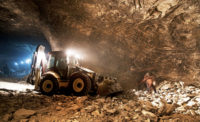Coal mining is an important part of the U.S. economy. In 2017, about 30% of our electricity was generated by coal-fired power plants. Coal is also used to make steel and in manufacturing many types of products. And anyone who watches the news knows how important the jobs and income provided by coal mining are to our country’s coal mining regions.
The mining of coal involves a lot of hard work in inherently risky settings. Those who operate and work in coal mines must constantly be on guard against a range of hazards, including respirable coal mine dust. The NIOSH Coal Workers’ Health Surveillance Program (CWHSP), which provides respiratory health screenings to coal miners, reminded us of this in a September report. It found that the most recent national prevalence of pneumoconiosis (black lung) in coal miners with 25 years or more tenure who participate in CWHSP screenings is 10%. The prevalence of black lung for these long-tenured miners in central Appalachia (Kentucky, Virginia, West Virginia) is 20%.
In addition to pneumoconiosis overall, another recent report indicates increasing numbers of coal miners with progressive massive fibrosis (PMF), an advanced, serious form of pneumoconiosis. In an August report, NIOSH investigators and their academic partners found that the percentage of claimants to the Department of Labor’s Black Lung Benefits Program with initial determinations of PMF increased from 0.6% in 1988 to 8.3% in 2014. Eighty-four percent of the miners with PMF determinations last mined in West Virginia, Kentucky, Pennsylvania, or Virginia. Another recent indication of an increasing burden of severe pneumoconiosis is provided in a July report documenting the growing frequency of lung transplants due to the disease. These follow reports in February and also from 2016 that describe large groups of mostly former coal miners seen in Appalachian clinics for PMF.
We can improve and protect the health of our nation’s coal miners and eliminate black lung by measuring and controlling respirable coal mine dust exposures. Furthermore, we can prevent severe disease by detecting black lung early, when actions can still be taken to stop the progression to advanced disease.
A recent report from the National Academies of Sciences, Engineering, and Medicinespeaks to the importance of monitoring representative respirable coal mine dust and silica exposure, controlling these exposures, and addressing barriers to miners’ participation in medical surveillance. NIOSH is using the valuable guidance provided by this report in its ongoing efforts to address these issues. Our job is not done until every miner can work a full career and enjoy a healthy retirement free from respiratory disease.
Upcoming NIOSH webinars:
-
Overlapping Vulnerabilities in the Aging Workforce
On October 30 from 12–1:30pm ET, the NIOSH Total Worker Health® Webinar Series, in conjunction with the National Center for Productive Aging and Work, presents the next installment in the Productive Aging and Work annual webinar series: Overlapping Vulnerabilities in the Aging Workforce. Aging does not happen in a vacuum. Social and economic dynamics and structures can shape the experience of aging. Join us for a discussion on a comprehensive perspective of productive aging—the support of safe and healthy work environments through integrated strategies that allow workers to be safe, healthy, and productive at all ages. Free continuing education for this activity is available. Register now to attend via Adobe Connect. -
New Insights into the Opioid Crisis and Work: Important Information for Workers and Employers
On November 6 from 1–2:30pm ET, the NIOSH Total Worker Health® Webinar Series presents a webinar focused on new research at the important intersection of work and the nation’s opioid crisis. Speakers will explore critical insights into potential work-related risk factors for opioid misuse, the latest data on opioid overdose by industry and occupation, and primary, secondary, and tertiary prevention methods and interventions. The presentation will also introduce the NIOSH response to the opioid crisis, helping to address the challenges facing our nation’s workers and workplaces related to opioids. Register now to attend via Adobe Connect.



